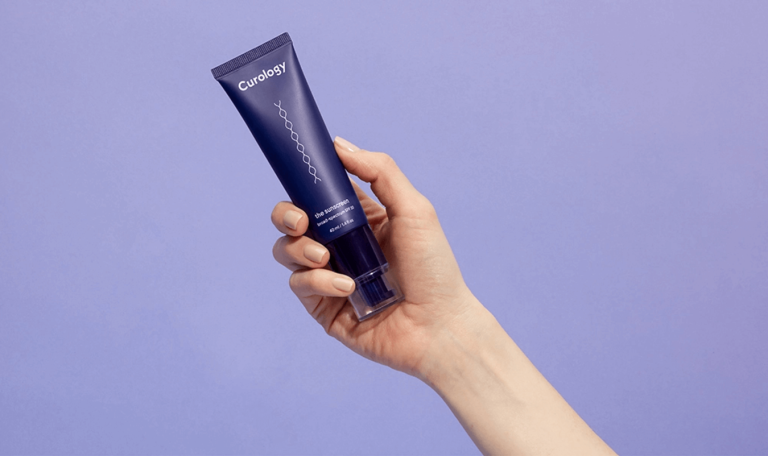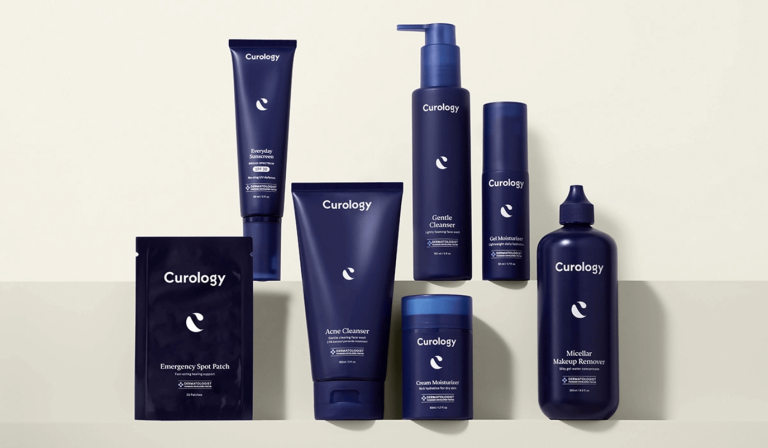How it works:
Share your skin goals and snap selfies
Your dermatology provider prescribes your formula
Apply nightly for happy, healthy skin
How it works:
How it works:
Share your skin goals and snap selfies
Your dermatology provider prescribes your formula
Apply nightly for happy, healthy skin
How it works:
6 ingredients you may want to avoid in skincare – check your labels
Make sure your products are working for you, not against you!



Have you ever felt like no matter how thorough your skincare routine was, your skin just wouldn’t improve? While there can be many factors that stall your progress as you target specific concerns like acne and signs of aging, one big reason may be that you’re using the wrong ingredients. In fact, not all products are created equally—and some contain ingredients that might even leave your skin worse off.
Needless to say, that can be extremely frustrating! Luckily, when you know what to look for, finding the right products for your unique skin gets a whole lot easier. And we’re here to help! Here, we’ll explain the top ingredients our team of licensed dermatology providers recommends avoiding and why.
1. Parabens
Parabens act as preservatives in a wide variety of cosmetic products and processed foods. They're cost-efficient, biodegradable, and protective against many types of germs. Common parabens include propylparaben and methylparaben.¹
The liver and intestines help clear parabens from food quickly, so they're likely not as harmful to health as topically applied parabens.² That’s why it’s a good idea to avoid them in skincare.
Parabens are hormone disruptors. Studies show they increase estrogen concentration in tissues and may appear in breast cancer cells.³ Parabens may also affect brain, nerve, and male hormonal functions.⁴
The FDA states that they lack cosmetic-specific information on parabens' effects on human health. If present, manufacturers usually declare them on their ingredient lists.⁵ Other companies, like us at Curology, ensure cosmetic products are free of any toxic chemicals, including parabens.
2. Fragrances
Fragrances are mixtures of aromatic ingredients that give cosmetics a pleasant smell. Artificial and natural forms are available—both can reduce indoor air quality, irritate the skin and inhibit breathing passages. They can also cause heart, brain, and nerve dysfunction.⁶ Additionally, research shows synthetic fragrances may lead to thyroid and sex hormone imbalance, skin and airway hypersensitivity, breast cancer, and liver toxicity.⁷
Current FDA rules don't make it easy to identify fragrance ingredients in skincare products. Manufacturers can simply list them as “fragrance” on labels, with their components kept as trade secrets.⁸ Also, many personal products claiming to be “fragrance-free” or “unscented” contain odor-masking agents that may cause allergies, severe headaches, and asthma symptoms.⁹
Iif you’re fragrance-sensitive, the FDA recommends checking ingredient labels and choosing fragrance-free products. You may also contact a product’s manufacturer for specific ingredient information.¹⁰
3. Phthalates
Phthalates are complex molecules with many functions. They can serve as fragrances, dye solvents, nail polish plasticizers, and others.¹¹ Diethyl phthalate (DEP) is currently the most commonly used phthalate in the beauty industry, though there are others.¹²
Research reveals that phthalates may contribute to the following:¹³
Allergies
Immune problems
Liver and kidney disease
Learning disorders
Various tumors
Endocrine disruption may also be an issue. Animal studies show phthalates may interfere with estrogens and thyroid hormones, and have been linked to diabetes. Phthalate syndrome is a condition presenting with male reproductive issues after long-term exposure to phthalates.¹⁴
Despite these findings, the FDA states that there's no strong evidence for phthalates' health hazards at cosmetic levels. If that's not reassuring enough, you can always avoid them. Choose phthalate-free or fragrance-free products.¹⁵

4. Oxybenzone and octinoxate
Oxybenzone and octinoxate are chemical UV filters commonly found in various sun protection products. Studies show Oxybenzone may cause thyroid and sex hormone disruption. Oxybenzone may increase the risk of kidney problems. For pregnant people, it mayalso increase the risk of Hirschsprung's disease, a birth defect that leads to missing nerve cells in the muscle of the large intestine.¹⁶ As for environmental impact, research shows both may damage coral reefs.¹⁷
There’s currently not enough evidence to show that these chemical sunscreens can impact human health and the environment.¹⁸ But the FDA excludes them nonetheless from their list of “GRASE” or “generally recognized as safe and effective” substances.¹⁹
Consider mineral sunscreens containing zinc oxide (such as Curology’s The Sunscreen) or titanium oxide, which are GRASE.
5. Triclosan and triclocarban
Triclosan and triclocarban are polychlorinated molecules with broad-spectrum antimicrobial properties.²⁰ They used to be common ingredients of personal hygiene products, however, the FDA banned them from hand and body cleansers in 2016.²¹
These chemicals can result in negative ramifications for both the environment and the human body. The following may stem from their use:²²
Death to algae and other aquatic life forms
Skin and eye irritation
Allergic reactions
Reproductive problems
Pregnancy issues
Thyroid toxicity
Muscle weakness
DNA damage
Antimicrobial resistance
Tumor growth
You may no longer find them in antibacterial soaps, which the FDA says aren’t superior to ordinary cleansers. But some toothpaste brands still use triclosan because it can prevent gum disease. Manufacturers must state on their list of ingredients if their product has triclosan.²³
6. Formaldehyde and its releasers
Formaldehyde is widely used in various products. In cosmetics, it usually serves as a chemical preservative in nail polish, eyelash glue, and cleansing products like babies’ liquid soaps.²⁴ Hair-smoothing agents also use formaldehyde-releasing molecules to be effective.²⁵
Formaldehyde and its releasers go by various names, some of which may be unfamiliar:²⁶
Formalin
Quaternium-15
Diazolidinyl urea
DMDM hydantoin
Imidazolidinyl urea
Bronopol or 2-bromo-2-nitropropane-1,3-diol
Many others
Skin exposure to formaldehyde may cause contact allergies.²⁷ Meanwhile, formaldehyde-releasing hair products have led to the following among hair salon workers and clients:²⁸
Eye and skin irritation
Neurologic problems
Shortness of breath
Chest pain
Vomiting
Rashes
The FDA requires manufacturers to name these chemicals on their product labels.²⁹ But formaldehyde often has hidden sources, such as inadvertent contamination.³⁰ Still, you may minimize exposure by checking ingredient lists. Additionally, report bad reactions to the FDA.³¹
What about FDA regulations?
As previously mentioned, the FDA doesn't regulate the cosmetic industry tightly, though they may recall personal care products when their risks outweigh their benefits. Generally, product labeling rules differ according to the ingredients they have.³² You can take charge of your skincare by choosing dermatologist-formulated products, like what we offer at Curology. You may also talk to a health professional if you have concerns about cosmetic side effects.
Are “green” or “organic” products any better?
An ingredient’s source doesn’t guarantee its safety. For example, some plant-derived substances can trigger allergies. The FDA doesn’t regulate substances claiming to be “organic,” as there are no legal regulations for the term.³³ Medical professionals also caution against “greenwashing.” Arbitrarily labeling products as “clean” or “natural” doesn't make them safer—it’s often just a marketing tactic!³⁴

Using the right ingredients for your skin
Understanding the ingredients to avoid in skincare is one half of the battle—so how do you know which ingredients to incorporate into your routine instead? That’s where we come in.
Get your personalized skincare routine with Curology
Get your personalized skincare routine with Curology


When you sign up for Curology, one of our licensed dermatology providers will help you figure out the best scientifically proven ingredients to help you target your biggest skin concerns. Plus, they’ll prescribe a custom formula for your unique skin. Get started today!*
FAQs
You can check the product label and search for the ingredients in the FDA Database. However, businesses don’t always disclose cosmetic ingredients entirely. If you develop a bad reaction to a beauty product, stop using it and seek medical help right away.
There’s no guarantee that any beauty brand is totally free of harmful chemicals. First, environmental contaminants can always spoil a cosmetic product. Second, everyone has different ingredient sensitivities. So what works on your friend may not work the same way on you. Consult Curology’s licensed dermatology providers to ensure you get only the skincare products that are suitable for your needs.
Yes, it is okay to use different products from different skincare brands—just be sure that every product in your routine is free of potentially harmful ingredients. That said, Curology makes it easy to follow a solid skincare routine with our suite of dermatologist-designed products.
P. S. We did the homework so you don’t have to:
Engeli, R.T., et al. Interference of Paraben Compounds with Estrogen Metabolism by Inhibition of 17β-Hydroxysteroid Dehydrogenases. International Journal of Molecular Sciences. (2017, September 19).
Engeli, R.T., et al. Interference of Paraben Compounds with Estrogen Metabolism by Inhibition of 17β-Hydroxysteroid Dehydrogenases. International Journal of Molecular Sciences. Ibid.
Engeli, R.T., et al. Interference of Paraben Compounds with Estrogen Metabolism by Inhibition of 17β-Hydroxysteroid Dehydrogenases. International Journal of Molecular Sciences. Ibid.
Khan, A.D. and Alam, M.N. Cosmetics and Their Associated Adverse Effects: A Review. Journal of Applied Pharmaceutical Sciences and Research. (2019, April 15).
U.S. Food and Drug Administration. Parabens in Cosmetics. (2022, February 25).
Radis-Baptista, G. Do Synthetic Fragrances in Personal Care and Household Products Impact Indoor Air Quality and Pose Health Risks? Journal of Xenobiotics. (2023, March 1).
Radis-Baptista, G. Do Synthetic Fragrances in Personal Care and Household Products Impact Indoor Air Quality and Pose Health Risks? Journal of Xenobiotics. Ibid.
U.S. Food and Drug Administration. Fragrances in Cosmetics. (2022, February 28).
Khan, A.D. and Alam, M.N. Cosmetics and Their Associated Adverse Effects: A Review. Journal of Applied Pharmaceutical Sciences and Research. Ibid.
U.S. Food and Drug Administration. Fragrances in Cosmetics. Ibid.
Giuliani, A., et al. Critical Review on the Presence of Phthalates in Food and Evidence of Their Biological Impact. International Journal of Environmental Research and Public Health. (2020, August 5).
U.S. Food and Drug Administration. Phthalates in Cosmetics. (2022, May 19).
Giuliani, A., et al. Critical Review on the Presence of Phthalates in Food and Evidence of Their Biological Impact. International Journal of Environmental Research and Public Health. Ibid.
Giuliani, A., et al. Critical Review on the Presence of Phthalates in Food and Evidence of Their Biological Impact. International Journal of Environmental Research and Public Health. Ibid.
U.S. Food and Drug Administration. Phthalates in Cosmetics. Ibid.
Suh, S., et al. The Banned Sunscreen Ingredients and Their Impact on Human Health: A Systematic Review. International Journal of Dermatology. (2020, February 28).
Guan, L.L., et al. Sunscreens and Photoaging: A Review of Current Literature. American Journal of Clinical Dermatology. (2021, August 13).
Guan, L.L., et al. Sunscreens and Photoaging: A Review of Current Literature. American Journal of Clinical Dermatology. Ibid.
Federal Register. Sunscreen Drug Products for Over-the-Counter Human Use. (2019, February 26).
Halden, R.U. On the Need and Speed of Regulating Triclosan and Triclocarban in the United States. Environmental Science and Technology. (2014, March 3).
U.S. Food and Drug Administration. Safety and Effectiveness of Consumer Antiseptics; Topical Antimicrobial Drug Products for Over-the-Counter Human Use. (2016, September 6).
Halden, R.U. On the Need and Speed of Regulating Triclosan and Triclocarban in the United States. Environmental Science and Technology. Ibid.
U.S. Food and Drug Administration. 5 Things to Know About Triclosan. (2019, May 16).
Jairoun, A.A., et al. Hidden Formaldehyde Content in Cosmeceuticals Containing Preservatives that Release Formaldehyde and Their Compliance Behaviors: Bridging the Gap Between Compliance and Local Regulation. Cosmetics. (2020, December 1).
Barreto, T., et al. Straight to the Point: What Do We Know So Far on Hair Straightening? Skin Appendage Disorders. (2021, March 30).
Goossens, A. and Aerts, O. Contact allergy to and allergic contact dermatitis from formaldehyde and formaldehyde releasers: A clinical review and update. Contact Dermatitis. (2022, March 1).
Goossens, A. and Aerts, O. Contact allergy to and allergic contact dermatitis from formaldehyde and formaldehyde releasers: A clinical review and update. Contact Dermatitis. Ibid.
Mohiuddin, A.K. Cosmetics’ Safety: Gray Areas with Darker Inside – Mini Review. South Asian Journal of Pharmaceutical Sciences. (2019, September 30).
U.S. Food and Drug Administration. Formaldehyde in Hair Smoothing Products: What You Should Know. (2021, March 2).
Jairoun, A.A., et al. Hidden Formaldehyde Content in Cosmeceuticals Containing Preservatives that Release Formaldehyde and Their Compliance Behaviors: Bridging the Gap Between Compliance and Local Regulation. Cosmetics. Ibid.
U.S. Food and Drug Administration. Formaldehyde in Hair Smoothing Products: What You Should Know. Ibid.
U.S. Food and Drug Administration. FDA Authority Over Cosmetics: How Cosmetics Are Not FDA-Approved, but Are FDA-Regulated. (2022, March 2).
U.S. Food and Drug Administration. “Organic” Cosmetics. (2022, February 25).
Rubin, C.B. and Brod, B. Natural Does Not Mean Safe – The Dirt on Clean Beauty Products. JAMA Dermatology. (2019, September 25).
Meredith Hartle is a board-certified Family Medicine physician at Curology. She earned her medical degree at Kirksville College of Osteopathic Medicine in Kirksville, MO.
*Cancel anytime. Subject to consultation. Results may vary.
Here at Curology, we currently focus on the diagnosis and treatment of acne, rosacea, and anti-aging concerns. We do not treat many of the conditions mentioned in this article. This is only for information purposes.

Curology Team

Meredith Hartle, DO